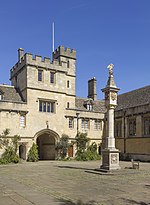Magpie Lane, Oxford

Magpie Lane is a narrow historic lane in central Oxford, England. It leads south from the High Street where it is at its narrowest, now completely pedestrianised as a pavement, and north from the cobbled Merton Street. To the west is Oriel College (including the Rhodes building of 1910 at the northern end) and to the east is University College, two of the oldest Oxford colleges. On the northeast corner there is a 1902 house, now the Quod restaurant. A small cul-de-sac street, Kybald Street, leads off Magpie Lane at the southern end to the east, giving access to the rear of University College and Kybald Twychen, owned by Corpus Christi College. South from Merton Street, the lane continues as Grove Walk (a.k.a. Merton Grove or Grove Passage) between Merton College to the east and Corpus Christi College to the west, giving pedestrian access via railinged gates to Dead Man's Walk, Merton Field, and Christ Church Meadows. The building in the south-western corner of Merton College is also called Grove. The name perhaps has been derived from this area having been used as an orchard.
Excerpt from the Wikipedia article Magpie Lane, Oxford (License: CC BY-SA 3.0, Authors, Images).Magpie Lane, Oxford
Kybald Street, Oxford City Centre
Geographical coordinates (GPS) Address Nearby Places Show on map
Geographical coordinates (GPS)
| Latitude | Longitude |
|---|---|
| N 51.751638 ° | E -1.253104 ° |
Address
Kybald Street
Kybald Street
OX1 4ET Oxford, City Centre
England, United Kingdom
Open on Google Maps









